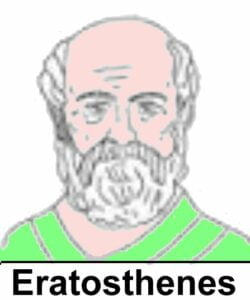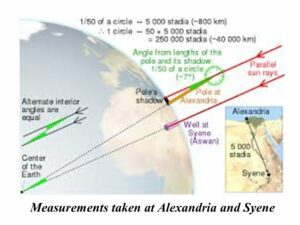Can your children work out how big the world is?
They can.
You see 2,000 years ago  Eratosthenes actually worked it out. It would be a superb exercise to see if he was correct, which, of course, he was!
Eratosthenes actually worked it out. It would be a superb exercise to see if he was correct, which, of course, he was!
Well, nearly.
He was a clever guy who lived in Egypt around 240BC.
To him it was obvious that the sun was a long way away, therefore, he assumed that when its ray hit us, they’d be parallel. Well, so close to parallel that it wouldn’t affect his calculations.
He lived in Alexandria, a port town where the Nile reached the Mediterranean.
How did he work it out?
Watching the sun and its shadows as it move throughout the day, he realised that for this to happen the world had to be round.
He also noticed that at midday in the summer, the sun’s rays were nearly vertical. In fact, he calculated the angle of the rays, well, when I say that, they didn’t actually have angles of degrees in those days. What he did was use an ancient unit of measurement, which was basically a circle very similar to today’s sun dial.
How did he prove it?
Having worked out the angle, then, this is the mad bit, he sent a man to walk 800 miles down the river Nile to Syene!
 When he got there, at the same time of the day, his man worked out the angle, and then he walked all the way back!
When he got there, at the same time of the day, his man worked out the angle, and then he walked all the way back!
You see the man had to walk it so that Eratosthenes had an accurate figure of the distance, which was essential for his calculations. They didn’t have Google Maps then!
With this data using the angles and the distance between them, he was able to calculate the speed the sun was moving around the earth and then, inevitably, the actual size of the earth.
Quite a mathematician!
Would you believe he nearly got it right?
He wasn’t perfect, he was just a little out, however, when you think about it this has to be some achievement, as this was over 2,000 years ago.
Using the information he had gathered he even worked out the world was on a tilt!
Some guy!
This leads to this question.
Could a maths class of children work out the circumference of the world using his information?
Of course, they really need to take a measurement at home, then on holiday, as long as it is on the same meridian.
That could be an expensive school trip!
Isn’t History Fun?
Ten questions to ask on this:
- Who was Eratosthenes, and what significant achievement is he known for?
- Describe Eratosthenes’ method for calculating the circumference of the Earth.
- What observations led Eratosthenes to conclude that the Earth was round?
- Explain the significance of the angle of the sun’s rays at noon in two different locations.
- How did Eratosthenes use the angle measurements to estimate the Earth’s circumference?
- What role did the distance between Alexandria and Syene play in Eratosthenes’ calculations?
- Why was it necessary for someone to physically measure the distance between Alexandria and Syene?
- Despite some discrepancies, why is Eratosthenes’ achievement considered remarkable?
- What additional conclusion did Eratosthenes draw about the Earth based on his calculations?
- How could a modern-day classroom replicate Eratosthenes’ experiment to calculate the Earth’s circumference?
To learn how he did it go to:
https://www.wikiwand.com/simple/Eratosthenes
https://www.uu.edu/dept/physics/scienceguys/2001July.cfm
A project for your school:
https://www.jpl.nasa.gov/edu/learn/project/make-a-scale-solar-system/
© Tony Dalton

